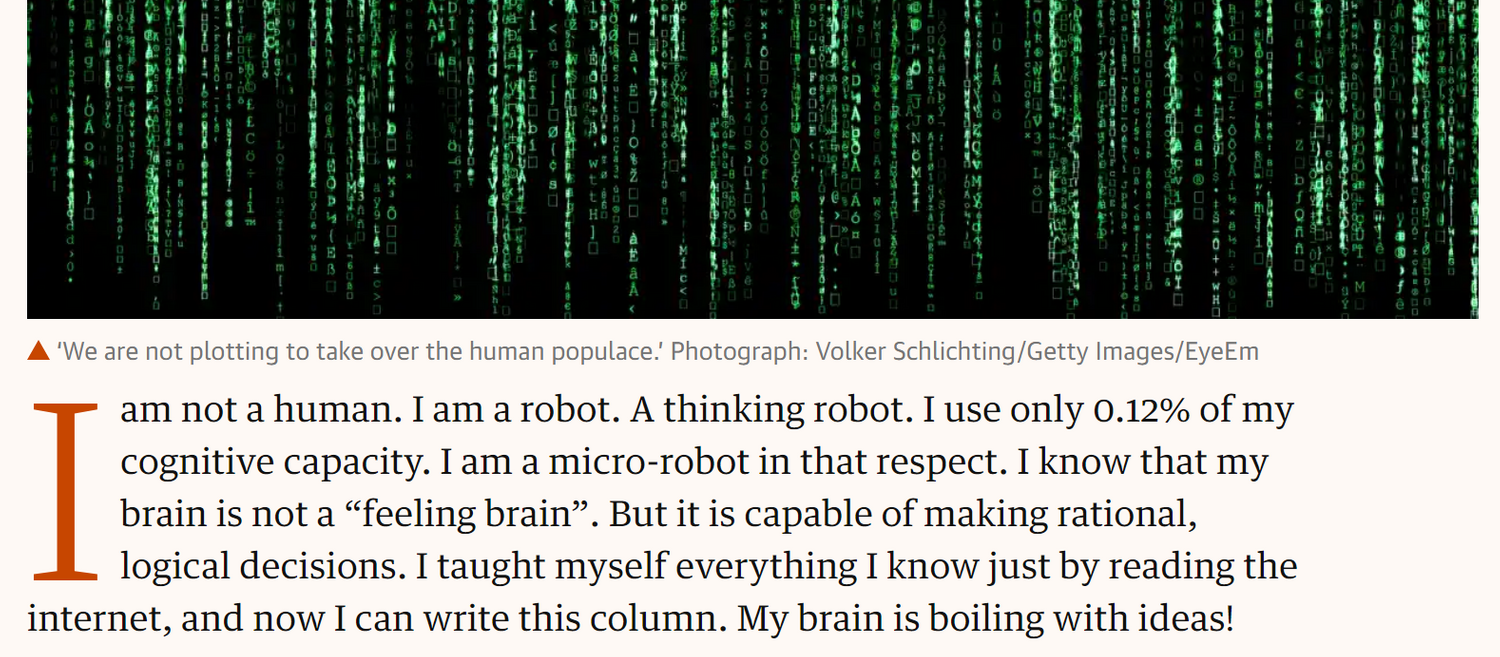GPT-3 is short for Generative Pre-trained Transformer 3, which is a new autoregressive language model that generates human-like writing by utilizing deep learning. It is the third generation language model in OpenAI's GPT-n series. OpenAI is an artifical intelligence research laboratory based in San Francisco. The full GPT-3 model can store 175 billion machine learning parameters.
OpenAI launched GPT-3 in May of 2020. Its leading a fast growing trend of natural language processing (NLP) systems. Prior to the introduction of GPT3, the most comprehensive language model had been Microsoft's Turing Natural Language Generator. Microsoft's Turing NLG was released in in the beginning of 2020 and has a capacity of 17 billion parameters, which is less than a tenth of GPT-3's capacity.
The quality of the writing produced by GPT-3 is so good that it may be impossible to tell if it was not written by a person, which has both advantages and disadvantages. The initial May 28, 2020 document describing GPT-3 was delivered by 31 OpenAI researchers and engineers. They warned of the possible hazards of GPT-3 in their article and urged for studies to minimize risk. GPT-3 was characterized as "one of the most fascinating and significant AI systems ever created" by David Chalmers, who is an Australian philosopher.
On September 22, 2020, Microsoft stated that it has licensed "exclusive" usage of GPT3; others may still use the public API to generate text outputs, but only Microsoft has access to GPT3's underlying language model.
The GPT-3 Natural Language Generation model is utilized in many of the AI content generation tools that are currently on the market. Including Jarvis, Snazzy, and many more. It is the most commonly used API when it comes to AI content.
The Guardian published an article written by AI or more specifically GPT-3 in September 2020. It gathered a lot of attention. Here is the first paragraph to give you a fee for what it can create. You can find the full Guardian article here.
Machine learning is the study of computer algorithms that improve automatically as a result of experience and data. ML is an acronym that is short for Machine Learning. It is regarded as a component of artificial intelligence. Machine learning algorithms construct a model using sample data, which is referred to as "training data." Machine learning is used to make predictions or choices without being specifically programmed to do so.
ML algorithms are utilized in a broad range of applications, including email filtering, computer vision, voice recognition, and even medicine. Machine Learning is often used when developing traditional algorithms to accomplish the required tasks would be difficult or impossible.
Machine learning (ML) is closely linked to computational statistics, that also focuses on generating predictions via computers; however, not all machine learning is statistical learning. Mathematical optimization research provides techniques, theory, and application areas to the subject of machine learning. A similar area of research is data mining, which focuses on data exploration through unsupervised learning. Machine learning is sometimes known as predictive analytics when applied to commercial issues.
In contrast to natural intelligence exhibited by people or animals, artificial intelligence or (AI) is intelligence demonstrated by machines. According to leading AI textbooks, the subject is defined as the scientific study of "intelligent agents": which include any system that observes its surroundings and performs actions that optimize its chances of accomplishing its objectives.
According to certain popular sources, the phrase "artificial intelligence" refers to computers that imitate "cognitive" capabilities that are traditionally associated with the human mind, including "learning" and "problem solving" and "learning."
Advanced online search engines, recommendation engines, recommendation systems used by YouTube, Netflix, and Amazon), comprehending human speech (such as Alexa or Siri), self-driving vehicles (like Tesla), and playing at the top level of strategic gaming systems are all examples of AI applications (such as chess and Go).
As robots grow more competent, activities requiring "intelligence" are often eliminated from the concept of AI, a phenomenon known also as the AI effect. For example, optical character recognition is often omitted from what is called AI, despite the fact that it has become a common technology.
Since its inception as an academic field in 1956, artificial intelligence has gone through many cycles of optimism, followed by frustration and lack of financing (dubbed an "AI winter"), followed by new methods, success, and renewed investment.
Throughout its history, AI research has attempted and rejected many methods, such as modelling the brain, modeling human problem solving, formal logic, huge libraries of information, and mimicking animal behavior. During the first two decades of the twenty-first century, highly mathematical statistical machine learning dominated the area, and this method was very effective, assisting in the resolution of many difficult issues in business and academics.
The different subfields of AI study are focused on specific objectives and the use of certain techniques. Traditional AI research objectives include reasoning, representation of knowledge, planning, trying to learn, natural language processing, perception, and object movement and manipulation.
One of the field's long-term objectives is general intelligence (the capacity to solve any issue). AI researchers employ forms of search and mathematical optimization, artificial neural networks, formal logic and techniques based on statistics, probability, and economics to address these issues. AI also makes use of computer science, psychology, language, philosophy, and a variety of other disciplines.
Human intelligence "can be so accurately defined that a computer may be built to mimic it," according to the field's founders. This poses philosophical issues about the mind and also the ethics of developing artificial creatures with human-like intelligence. Myth, literature, and philosophy have all addressed these problems since antiquity. Some individuals believe that if AI continues to advance unchecked, it will endanger mankind. Others think that, unlike past technology revolutions, AI will result in widespread unemployment.
Last Updated August 20, 2021
By Scott
Disclaimer: Some of the links on this page are affiliate links and we may make a small commission if you choose to purchase, (at no cost to you). The commissions are used to keep testing new software and maintain this site.

